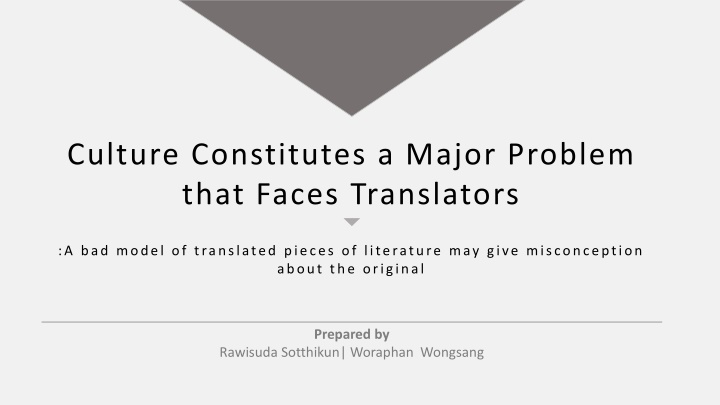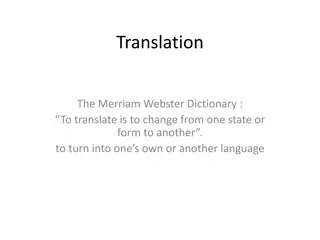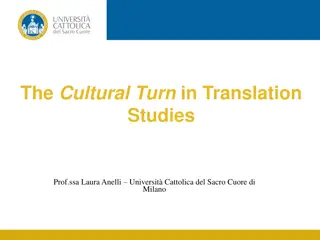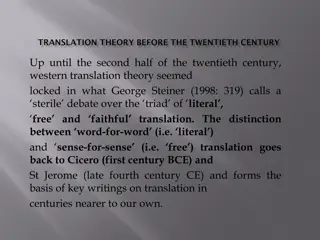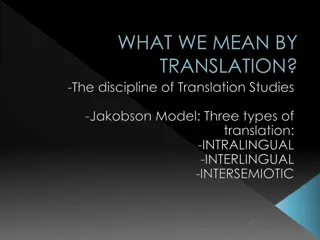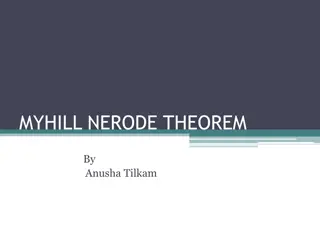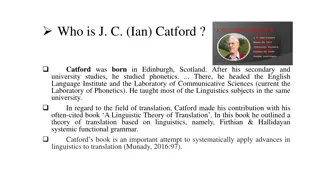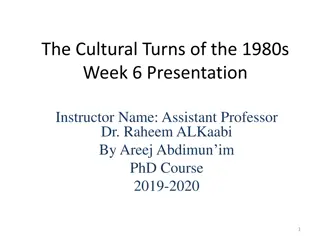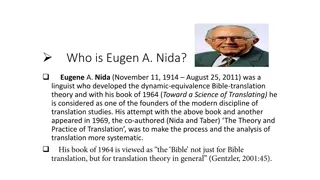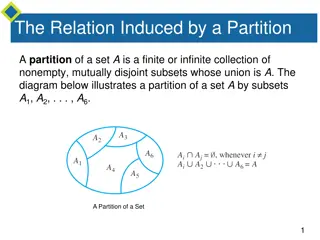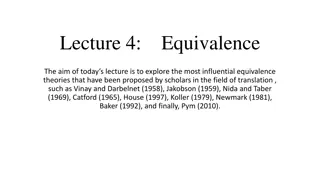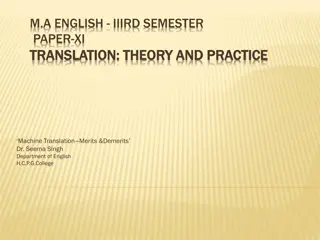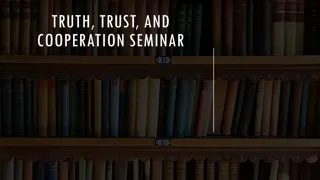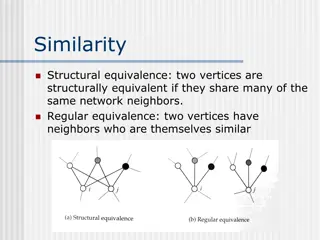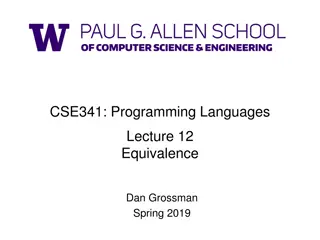Challenges in Cultural Translation: Misconceptions and Equivalence
Cultural differences pose significant challenges for translators, leading to potential misconceptions and loss of meaning in the translated text. Issues of experiential equivalence, word-for-word translations, and cultural untranslatability are explored through various theories and examples. Understanding these complexities is crucial for achieving accurate and meaningful translations across different cultures.
Uploaded on Feb 27, 2025 | 2 Views
Download Presentation

Please find below an Image/Link to download the presentation.
The content on the website is provided AS IS for your information and personal use only. It may not be sold, licensed, or shared on other websites without obtaining consent from the author.If you encounter any issues during the download, it is possible that the publisher has removed the file from their server.
You are allowed to download the files provided on this website for personal or commercial use, subject to the condition that they are used lawfully. All files are the property of their respective owners.
The content on the website is provided AS IS for your information and personal use only. It may not be sold, licensed, or shared on other websites without obtaining consent from the author.
E N D
Presentation Transcript
Culture Constitutes a Major Problem that Faces Translators :A bad model of translated pieces of literature may give misconception about the original Prepared by Rawisuda Sotthikun| Woraphan Wongsang
THEORY Larson s Translation Process & Newmark s Translation Process
Translation Process Larson
Translation Process Newmark
Jandts Intercultural Communication Translation problems occur through the lack of experiential equivalence when the experience doesn t occur in one s culture.
Think of objects or experiences that appear in your culture and not in the other. A word-for-word translation may cause the loss of the specific meaning of words.
Nida, 1964 Differences between cultures may cause more severe complications for the translator than do differences in language structure.
Something is culturally untranslatable when there is no equivalent situational feature in the source language. Catford (1965) Daungta Supon (1998) Cultural differences between the source and target languages can cause problems in translation.
Bad Model From Harry Potter
Generic word to Specific word Generic to specific word" is a word which grouped in a class of things, and translated into the specific details of something.
EXAMPLE The source language The receptor language It was nearly midnight, and he was lying on his stomach in bed. The blankets drawn right over head like a tent The receptor language
EXAMPLE The source language The receptor language So Harry had had no word from any of wizarding friends for five long weeks. The receptor language .
EXAMPLE The source language The receptor language This separation from his spell books is a real problem for harry. The receptor language
EXAMPLE The source language The receptor language ''I hope there's something good for lunch.'' The receptor language
Four Reigns Seen in the selected Thai film Translation from Thai to English
WORD-FOR-WORD TRANSLATION T E C H N I Q U E
TOPKNOT CUT : : Topknot cut Tonsure
FREE & ADAPTATION TRANSLATION T E C H N I Q U E
Tigers and crocodiles can never be nurtured in a house : :Tigers and crocodiles can never be nurtured in a house : ! : Go then! Get out! Tigers and crocodiles can never be nurtured in a house
FORTUNE-TELLING SYSTEM Translation by using descriptive statements : :Fortune-telling system ...fortune-telling system, whereby you rattled the stick-box until one stick fell out whose number matched that of one of the prophecies, written in verse, printed on flimsy paper and couched in terms so verbose and ambiguous as to mean anything at all you wanted it to mean
T R A N S L AT I O N T E C H N I Q U E Translation by using Transcription & explanation
So, in 1892 Phloi was ten years old. Had someone asked her then who her father was, she would have answered that his name was Phraya Phiphit and her mother s Chaem. Mother was Phraya Phiphit s Number One Wife but didn t have the status of Khunying (Dame), because his first wife and thus khunying was Ueam. * A high-level nobility title for men in royal service, addressed as Jaokhun : :Khunying
When the meal was over, Phit, a servant Mother had taken into her service at the cost of twelve tamlueng , would eat what was left and do the dishes. A unit of 60 grams of silver : :Tamlueng
Cultural Cultural Substitutes Substitutes (Larson, 1998) Translation by using substitutes which known as well in Thai language
Cultural Cultural Substitutes Substitutes (Larson, 1998) She is a Helen of Troy= Here comes our Casanova! = Tom was the black sheep of the family = Mr. Y or Mr. Z, reading of me =
Bystander This is called the bystander effect whereby behavior is influenced by the diffusion of responsibility. Bystander in the SL means a person who sees something that is happening but is not involved is translated using the Thai equivalent to bystander in the RL which can be comparable and easily understood by the reader.
Jesus Christ When she didn t answer, he stepped nearer. You oughten to sleep out here, he said disapprovingly; and then he was beside her and Oh, Jesus Christ! He look about helplessly, and he rubbed his beard. ! The word Jesus Christ refers to the man on whose life and teachings Christianity is based. The translator uses Lord Buddha helps which is a Thai exclamation commonly expressed.
Larson, 1984 When the cultures are similar, there is less difficulty in translating. This is because both languages will probably have terms that are equivalent for the various aspects of the culture. When the cultures are very different, it is often difficult to find equivalent lexical items.
THANK YOU Time to discuss We are glad to answer all of your questions
